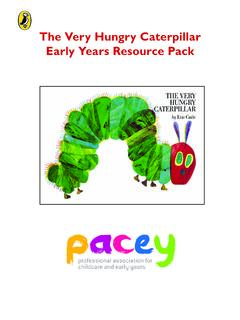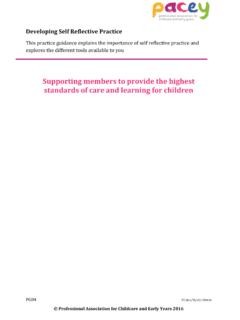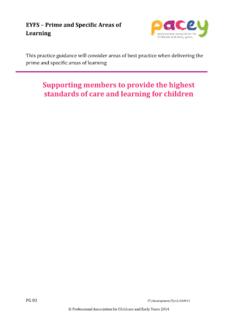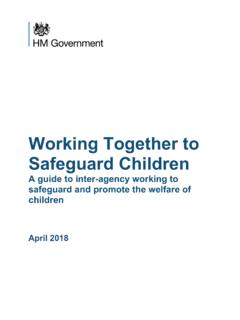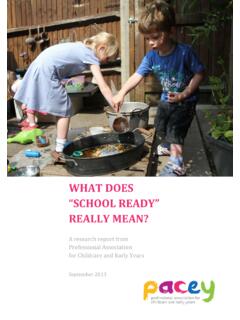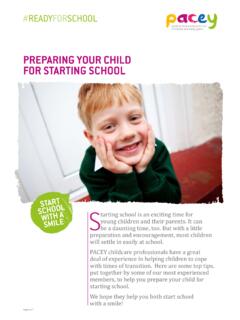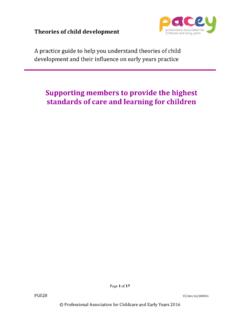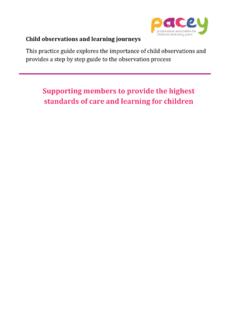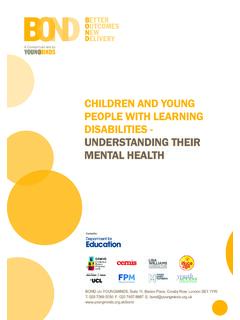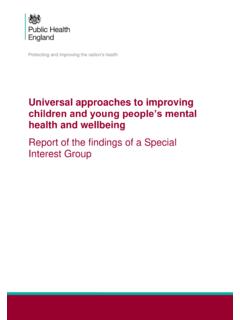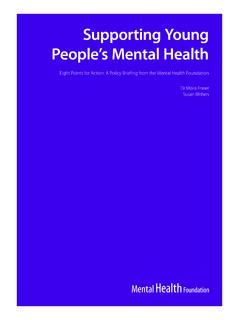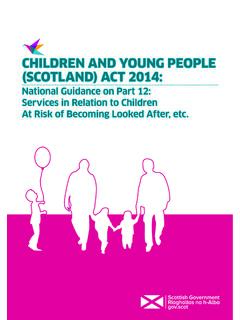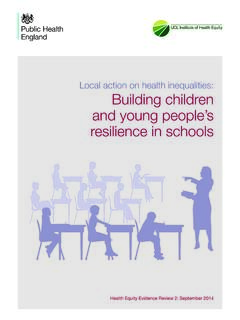Transcription of The role of childcare professionals in supporting mental ...
1 The role of childcare professionals in supporting mental health and wellbeing in young people : a literature review Ione Inness The following literature review was prepared by Ione Inness whilst on an internship programme at the Professional Association for childcare and Early Years (PACEY), December 2015 The importance of early years and the role of the childcare professional supporting children s health At present, 1 in ten children and young people suffer from mental health problems. Evidence of symptoms are demonstrated through depression, anxiety and behavioral disorders.
2 Positive mental health enables children to develop their resilience and grow into well-rounded adults. Recent research suggests that children are more likely to suffer from mental health issues than 30 years ago (Mind, 2015). The first years of life are critical for a child s social and emotional development (Ashdown and Bernard, 2012). Babies are vulnerable and totally dependent on others for their survival. From the beginning babies are only aware of their immediate needs (if they are wet, hungry, in need of attention etc). One of the first social emotions that babies display is when their caregiver leaves the room - the baby s cry can act as a signal that they are unhappy and needing help.
3 Thus by the end of their first year babies are primed to develop crucial ties to their parents or other significant adults (Jones et al, 2015). Usually, but not always it is their mother they learn to trust because consistency and loving care teaches a baby about the importance of developing a deep emotional bond with another. Attachment This period of a child s development is called attachment. John Bowlby (1907 1990 cited in Berant, 2013) was a psychoanalyst who believed mental health and behavioural problems could be recognised in early childhood. Bowlby s revolutionary attachment theory proposed that children enter the world biologically pre-programmed to form attachments with others, because this helps them to survive.
4 Furthermore, Bowlby believed that attachment behaviours are innate and can be activated by conditions that seem to threaten the achievement of proximity, such as separation, insecurity and fear (Berant, 111: 2013). It is this natural instinct in babies that propels them to seek safety and comfort from their primary caregivers when they perceive an imminent threat or discomfort. The term 2 | P a g e attachment also describes the availability of the caregiver towards the child. In practice this means how the caregiver responds to the baby s needs for physical and emotional closeness.
5 A strong attachment between baby and caregiver helps develop a deep internal blueprint of positive relationships. Additionally, these characteristics help shape a child s sense of self, gives them their first introduction to their own autonomy and helps regulate their emotions (Blair and Cybele Raver, 2014). Self-regulation One of the most important responsibilities which parents undertake when their baby is born is teaching their offspring how to regulate their thoughts, emotions and behavior. Theorists believe that children who reach adolescence without developing this ability are more likely to do badly in school, demonstrate aggressive behavior, abuse substances, engage in high-risk sexual behavior and as a result of any or all of these generally experience negative life events (Houghton et al, 201, Canada Education, 2015).
6 Sadly, parents who have difficulties in this area themselves can therefore struggle to pass these skills down. However, some experts suggest that most if not all major problems that affect individuals of all ages in our society, including a number of health problems and mental issues, can be traced in some way to an inability to appropriately control aspects of the self (Reading et al, 2008,Blair and Cybele Raver, 2014). Nowadays, self-regulation is closely aligned with self-control and in some areas the two overlap both are used to achieve the same goal.
7 However, the difference lies in when a challenge arises between our current state and our desired state, and we become motivated to change our mental and emotional behaviour. The concept of self-control describes the conscious effort to change behaviour and thus reduce the challenge, while self-regulation comprises this as well as more instinctive processes and both are important in human development. Nursery setting example Ben and Harry are playing together happily building dens in the nursery garden. They work together to build Harry s den first, using seat cushions from the bench in their playground and the underneath of the bench as a tunnel lining the ground with the seat cushions.
8 As they construct Harry s den an argument breaks out between them about the materials they re using for Harry s den that results in Ben pushing over Harry s den and walking off leaving Harry standing next to his broken den in tears. An older child in the nursery comforts Harry and a nursery worker who has been observing their play talks to both of them. A few minutes later they smile at each other and both return to playing in Harry s den . The concept of self-regulation in this example is demonstrated by the boys calming down and shifting from their strong emotions to calm emotions which allows them to play together again.
9 The ability of both of the boys to transform their unruly behaviour and compose themselves is an important tool. Self-regulation can benefit a child 3 | P a g e through their entire life from test preparation, interviews, sporting events, homework completion, and musical performance to simply calming themselves for restful sleep. Self-soothing is an ability that is an essential part of emotional regulation: the ability to shift from powerful emotions to calm emotion in order to prevent all-consuming anxiety (Blair and Cybele-Raver, 2014). Since the 1990s researchers have reported that self-regulation can be a limited resource.
10 Houghton, (2011) likens the process of self-regulation to a muscle that gets tired, as a result a conscious act of self-control causes diminished performance in an immediately subsequent test of self-control. Thus, just as exercise facilitates stronger muscle mass, regular use of self-control improves willpower strength. Additionally, there is further positive news that in the same way that athletes can end the race with a last bit of energy with a final push, people with dwindling energy reserves of self-control can gather their last resources to meet a further demand before requiring time for renewal.
